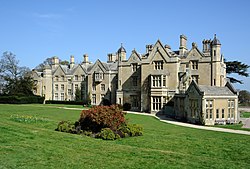Dumbleton
| Dumbleton | |
| Gloucestershire | |
|---|---|
 Village Drinking Fountain | |
| Location | |
| Grid reference: | SP016360 |
| Location: | 52°1’21"N, 1°58’41"W |
| Data | |
| Population: | 576 (2011) |
| Post town: | Evesham |
| Postcode: | WR11 |
| Dialling code: | 01386 |
| Local Government | |
| Council: | Tewkesbury |
| Parliamentary constituency: |
Tewkesbury |
Dumbleton is a village in Gloucestershire, roughly twenty miles from the city of Gloucester.
The village is on the edge of Dumbleton Hill, a foothill of the Cotswolds (and is accounted within the Cotswolds Area of Outstanding Natural Beauty). Dumbleton is mainly residential.
By the village stands Dumbleton Hall, which now functions as a hotel.
The civil parish also includes the villages of Great Washbourne, Little Washbourne and Wormington, all of which were separate civil parishes until 1935.[1]
The village is known to have existed in the time of King Æthelred I, who granted land to Abingdon Abbey, and it is mentioned in the Domesday Book.[2]
Parish church

St Peter's Church is of Norman origin with mainly 13th-century additions. The chancel was rebuilt in 1862. In 1960 it was designated a Grade I Listed Building.[3]
The travel writer Sir Patrick Leigh Fermor is buried in the churchyard with his wife Joan (née Eyres Monsell) and brother-in-law Lord Monsell. Inside St Peter's Church is a memorial to their relative, Arctic explorer Gino Watkins. The merchant banker and political fundraiser Lord Hambro is also buried in the churchyard. A large painted monument dedicated to Sir Charles Percy son of the Earl of Northumberland and Dorothy Cocks, his wife, is also to be found within the church. The colourful monument of two figures kneeling over their deceased child is situated within a deep round-headed niche flanked by free-standing Corinthian columns.[4]
The redundant St Mary's Church in Little Washbourne is also in the parish of Dumbleton.
The parish was in the possession of Abingdon Abbey until the Dissolution of the Monasteries.
The Old Rectory

The origin and development over the years of the Old Rectory is still subject to debate.[5] The home as it stands today was constructed in the 17th century.
It is notable that the home is now divided into two parts with what are called the north and south wings. The south wing incorporates a 16th-century timber-framed house with detailed decorative patterning.[6] The wings have separate private owners.
A blocked window at the rear of the house has a painted trompe-l'oeil of another window from which the Revd. Charles Cocks is seen looking out. His likeness was copied from a painting found in Eastnor Castle. The trompe l'oeil painting was painted by artists Roy Amiss and Benoit Gardner.[7]
Both the north and south portions of the Old Rectory are Grade II listed.[8][9]
Dumbleton Hall

- Main article: Dumbleton Hall
The original Dumbleton Hall can be traced from around 1534, as the home of the Cocks family for over 200 years. After the death of Sir Richard Cocks in the late 18th century, the Hall fell into disrepair and was eventually demolished.
Rebuilt in the mid-19th century using Cotswold stone, Dumbleton Hall became home to the Eyres family and in the 1930s, the Hall was well known for its popular house parties with regular guests including John Betjeman, later to become Poet Laureate.
During the Second World War, the Hall was allegedly considered as a suitable alternative venue for the House of Lords. It is also suggested that Hitler 'reserved' the Hall to be as a private residence were he to achieve his hoped-for victory in Europe.[10]
Following the death of the last member of the Eyres family to own the Hall, Caroline Mary Sybil Eyres-Monsell, Viscountess Monsell, formerly married to Bolton Eyres-Monsell, 1st Viscount Monsell, the Hall was sold and her son Graham and daughter Joan moved into the Mill House on the Dumbleton Hall estate. They were buried in Dumbleton as was Joan's husband Sir Patrick Leigh Fermor.
The Hall became a hotel in 1959.
Dumbleton Hall is Grade II* listed.[11]
Society
- Cricket: Dumbleton Cricket Club
- Social:
- Dumbleton Garden Club
- Dumbleton Social Club
- Dumbleton Village Hall
Outside links
| ("Wikimedia Commons" has material about Dumbleton) |
- Dumbleton Society
- Information on Dumbleton from GENUKI
- Dumbleton Garden Club
- Dumbleton Village Hall
- Dumbleton Cricket Club
- Dumbleton Village Club
References
- ↑ Vision of Britain
- ↑ "Open Domesday". Archived from the original on 27 December 2014. https://web.archive.org/web/20141227014656/http://domesdaymap.co.uk/place/SP0135/dumbleton/. Retrieved 6 April 2012.
- ↑ National Heritage List 1154563: St Peter's Church
- ↑ "Gloucester Parish Church Montages". http://www.rootsweb.ancestry.com/~engcots/DumbletonPhotos.html. Retrieved 6 April 2012.
- ↑ "Dumbleton Village Website". Archived from the original on 26 February 2012. https://web.archive.org/web/20120226121314/http://www.dumbletonvillage.co.uk/Buildings/Privatedwellings/TheOldRectory/tabid/120/Default.aspx. Retrieved 6 April 2012.
- ↑ Verey and Brooks (2002). Pevsner Architectural Guide, Gloucestershire 2: The Vale and The Forest of Dean. Yale University Press. pp. 343.
- ↑ "Dumbleton Village Website". Archived from the original on 26 February 2012. https://web.archive.org/web/20120226121314/http://www.dumbletonvillage.co.uk/Buildings/Privatedwellings/TheOldRectory/tabid/120/Default.aspx. Retrieved 6 April 2012.
- ↑ National Heritage List 1340141: Dumbleton Old Rectory – North
- ↑ National Heritage List 1154864: Dumbleton Old Rectory – South
- ↑ "Nights in the Past". http://www.nightsinthepast.com/worcestershire.html. Retrieved 6 April 2012.
- ↑ National Heritage List 1091709: Dumbleton Hall
- Verey, David: 'Gloucestershire: the Vale and the Forest of Dean' The Buildings of England series edited by Nicholas Pevsner, 2nd ed (1976) ISBN 0-14-071041-8